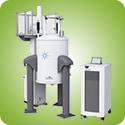Access Agilent eNewsletter, May 2014
>> Update My Profile | Subscribe to Access Agilent | Article Directory

New Agilent ProPulse System – a true user-focused platform for industrial chemical analysis
By Péter Sándor
Agilent Applications, NMR Applications Scientist
For many industrial analytical problems, nuclear magnetic resonance (NMR) spectroscopy provides answers that other techniques cannot. The new Agilent ProPulse NMR console with flexible Agilent VnmrJ software delivers high productivity and consistent data quality with simple push-button operation. In the following examples we illustrate how use of NMR technology can solve three chemical application challenges.
 Enlarge
Enlarge
Figure 1. 13C spectrum of a low-density polyethylene (LDPE) sample at 150 MHz in C2D2Cl4 at 120 °C. The S/N ratio of the main peak exceeds 60,000. The vertical scale of the inset is multiplied by a factor of 100.
 Enlarge
Enlarge
Figure 2. 1H convection compensated diffusion (DOSY) map of a high-density polyethylene (HDPE) demonstrating clear separation of the additives used for polymer composition. (temperature: 120 °C, solvent: C2D2Cl4)
 Enlarge
Enlarge
Figure 3. 93.3 MHz 29Si RIDE spectrum of an industrial water glass (A), a KOH sample of identical ionic strength (B), and an empty probe (C) demonstrating perfectly flat natural baseline quality for reliable quantification.
Superior hardware performance enables easy polymer structural characterization
13C NMR is among the most powerful tools available for structure elucidation of polymers, enabling easy and informative study of branching, tacticity, copolymer composition, and many other properties. Such high dynamic range samples require optimum sensitivity and perfect resolution and line shape, as well as efficient decoupling schemes, so that even the weakest signals can be reliably observed and identified (Figure 1).
Direct analysis of complex mixtures with diffusion ordered spectroscopy (DOSY)
Most industrial products are complex mixtures of multiple components present at very different concentrations; the physical separation of these components is often very difficult or even impossible to accomplish. NMR technology makes it possible to separate the spectra of components based on their size – and therefore diffusion properties – eliminating the need for separation techniques. Additives that have fundamental effects on the physical properties of polymers and oil derivatives can easily be monitored – even at high temperatures (Figure 2).
Highest data quality for analysis of complex mixtures
Industrial water glasses are characterized by distinct concentration ratios of the structurally different SiO4 units present (from monomers (Q0) to cross-linking groups (Q4)). In the 29Si NMR spectra of water glasses, the chemical shifts of the signals are structure dependent, but line widths may cover a wide range (5-700 Hz), and the Q3-Q4 signals do overlap with the solid silicon signals of the NMR tube. Because silicon-free NMR probe heads and silicon-free NMR tubes are not economically viable in industrial high-throughput environments, high-quality raw data – especially perfectly flat baselines – are vital for obtaining reliable integrals (Figure 3). Agilent’s unique baseline data performance helps eliminate the need for specialized and expensive accessories and consumables.
RIDE (ring-down eliminated) 29Si NMR spectra on Agilent spectrometers filter out the silicon background of the probe-head and allow for reliable correction for signals originating from NMR tubes.
The new Agilent ProPulse NMR System—simply better
The Agilent ProPulse NMR System brings the power of NMR to researchers of all types and skill levels. ProPulse delivers the highest quality data and unrivaled simplicity for highly-productive experimental setup, optimization, and data collection.
- Broad applicability: chemicals, polymers, surfactants, adhesives, additives, lubricants, coatings and more
- Quantification and structural identification: products, byproducts, impurities and additives
- Polymer characterization: product analysis, identification, tacticity, branching, copolymer composition and authentication
- DOSY: direct analysis of complex industrial mixtures without physical separation
- Reliable: quantitation without internal reference
Agilent is committed to improving the entire NMR user experience. See how Agilent brings true ease-of-use to high-performance NMR in this video overview of the Agilent ProPulse NMR System. Discover the complete line of Agilent NMR solutions that can be used to analyze both small- and large-molecule compounds in research and industrial applications.
>> Update My Profile | Subscribe to Access Agilent | Article Directory
Figure 1.

13C spectrum of a low-density polyethylene (LDPE) sample at 150 MHz in C2D2Cl4 at 120 °C. The S/N ratio of the main peak exceeds 60,000. The vertical scale of the inset is multiplied by a factor of 100.

